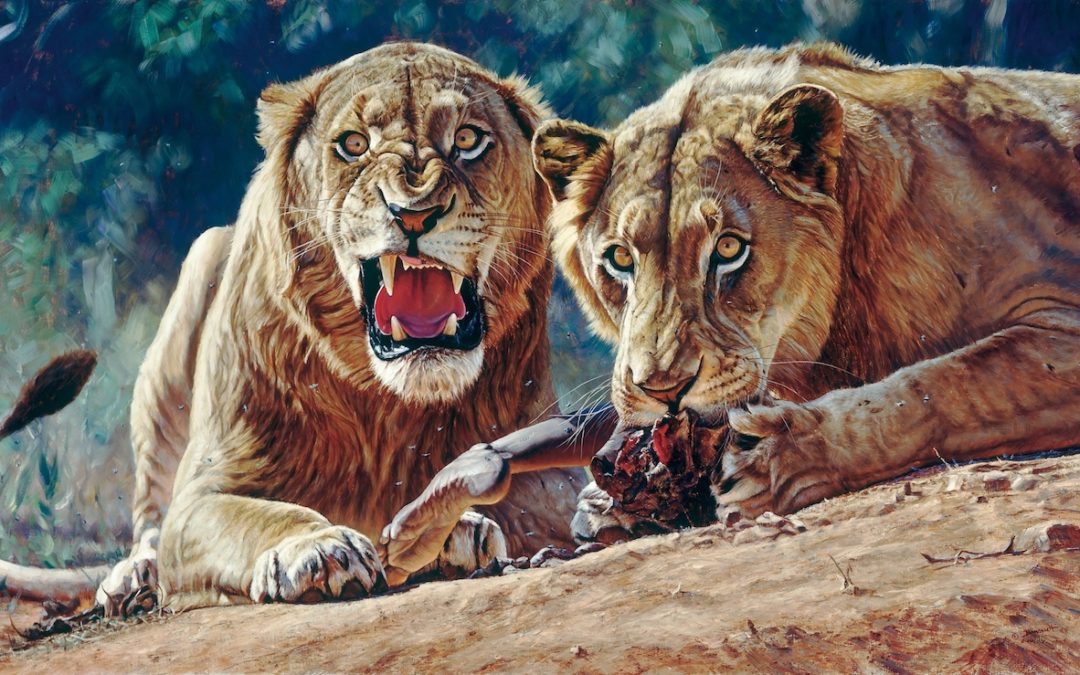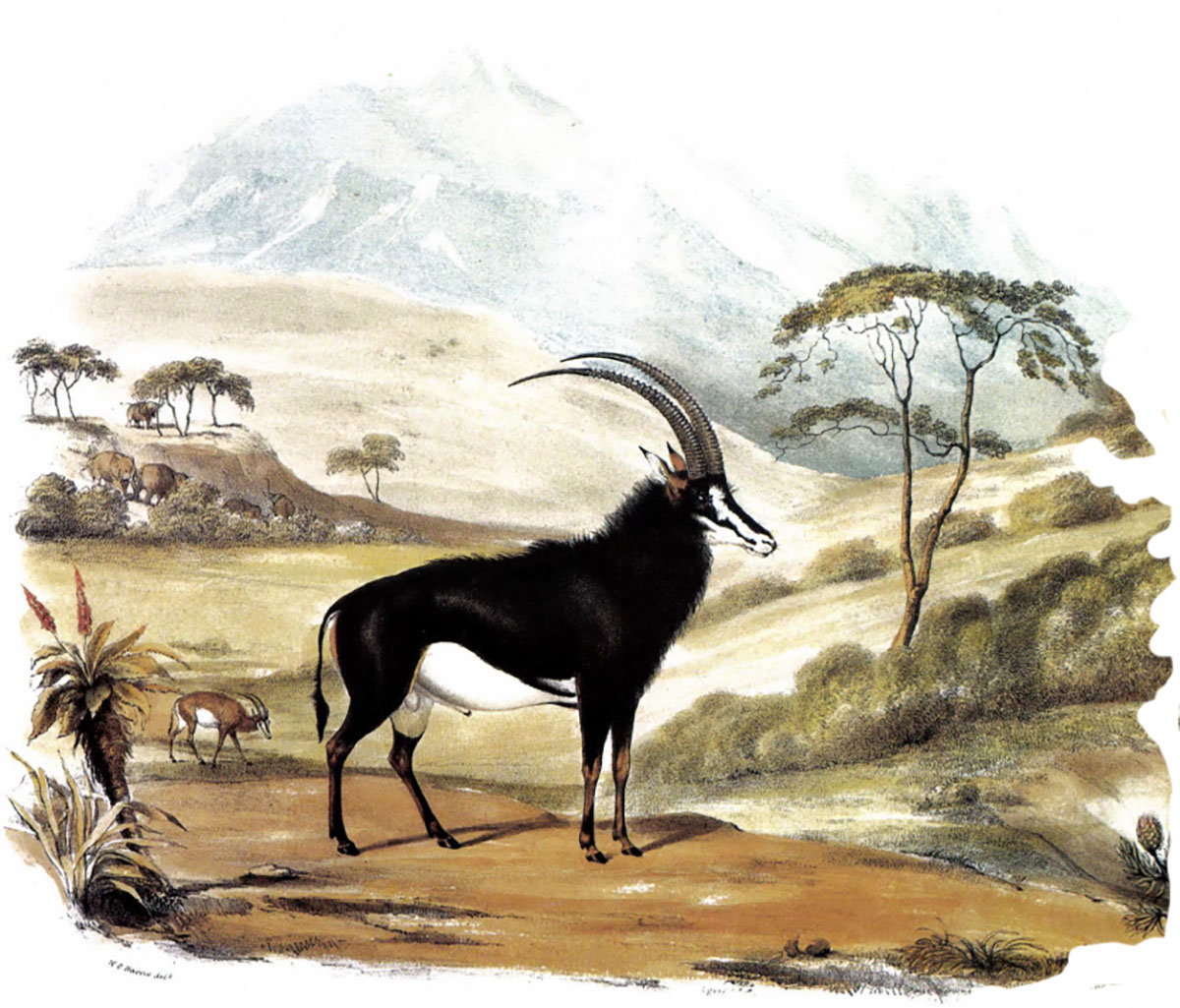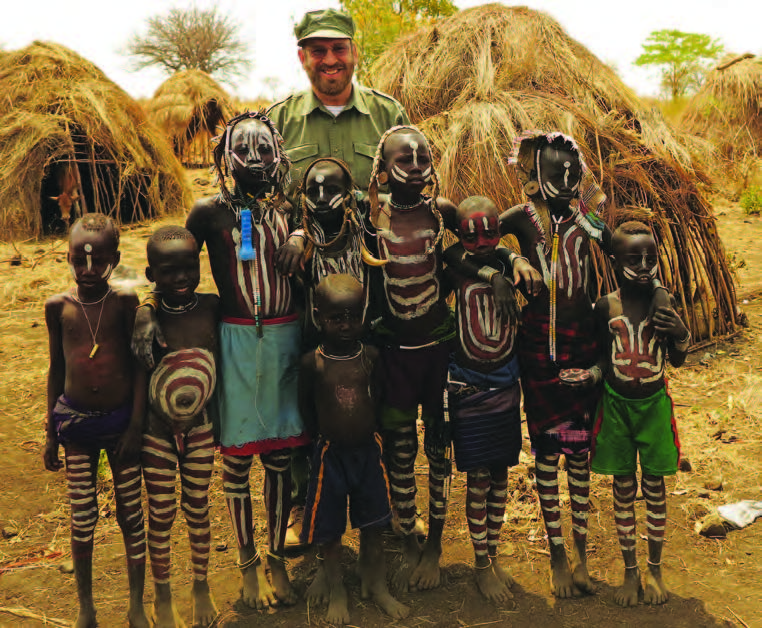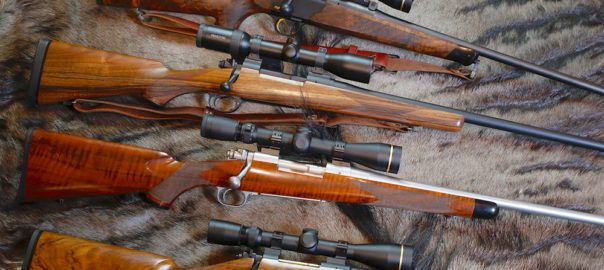Taking down the two infamous man-eating lions of Tsavo was no small task, but John Patterson was up to the challenge. Here’s how he did it.
A day or two after the departure of my allies, as I was leaving my boma soon after dawn on December 9, I saw a Swahili running excitedly towards me, shouting out “Simba! Simba!” (“Lion! Lion!”), and every now and again looking behind him as he ran. On questioning him I found that the lions had tried to snatch a man from the camp by the river, but being foiled in this had seized and killed one of the donkeys, and were at that moment busy devouring it not far off. Now was my chance.
I rushed for the heavy rifle that Farquhar had kindly left with me for use in case an opportunity such as this should arise, and, led by the Swahili, I started most carefully to stalk the lions, who, I devoutly hoped, were confining their attention strictly to their meal.
I was getting on splendidly, and could just make out the outline of one of them through the dense bush, when, unfortunately, my guide snapped a rotten branch. The wily beast heard the noise, growled his defiance and disappeared in a moment into a patch of even thicker jungle close by. In desperation at the thought of his escaping me once again, I crept hurriedly back to the camp, summoned the available workmen, and told them to bring all the tom-toms, tin cans and other noisy instruments of any kind that could be found. As quickly as possible I posted them in a half-circle round the thicket and gave the head jemadar instructions to start a simultaneous beating of the tom-toms and cans as soon as he judged that I had had time to get round to the other side.
I then crept round by myself and soon found a good position—one that the lion was most likely to retreat past, as it was in the middle of a broad animal path leading straight from the place where he was concealed. I lay down behind a small ant hill and waited expectantly. Very soon I heard a tremendous din being raised by the advancing line of coolies, and almost immediately, to my intense joy, out into the open path stepped a huge maneless lion. It was the first occasion during all these trying months upon which I had had a fair chance at one of these brutes, and my satisfaction at the prospect of bagging him was unbounded.

Slowly he advanced along the path, stopping every few seconds to look round. I was only partially concealed from view, and if his attention had not been so fully occupied by the noise behind him, he must have observed me. As he was oblivious to my presence, however, I let him approach to within about 15 yards of me and then covered him with my rifle. The moment I moved to do this he caught sight of me, and seemed much astonished at my sudden appearance, for he stuck his forefeet into the ground, threw himself back on his haunches, and growled savagely.
As I covered his brain with my rifle, I felt that at last I had him absolutely at my mercy…but never trust an untried weapon! I pulled the trigger, and to my horror heard the dull snap! that tells of a misfire.
Worse was to follow. I was so taken aback and disconcerted by this untoward accident that I entirely forgot to fire the left barrel and lowered the rifle from my shoulder with the intention of reloading—if I should be given time. Fortunately for me, the lion was so distracted by the terrific din and uproar of the coolies behind him that instead of springing on me, as might have been expected, he bounded aside into the jungle again. By this time I had collected my wits, and just as he jumped I let him have the left barrel. An answering angry growl told me that he had been hit; nevertheless, he succeeded once more in getting clear away, for although I tracked him for some little distance, I eventually lost his trail on a rocky patch of ground.
Bitterly did I anathematize the hour in which I had relied on a borrowed weapon, and in my disappointment and vexation I abused owner, maker and rifle with fine impartiality. On extracting the unexploded cartridge, I found that the needle had not struck home, the cap being only slightly dented; so that the whole fault did indeed lie with the rifle, which I later returned to its maker with polite compliments.
Seriously, however, my continued ill-luck was most exasperating, and the result was that the Indians were more than ever confirmed in their belief that the lions were really evil spirits, proof against mortal weapons. Certainly, they did seem to bear charmed lives.
After this dismal failure there was, of course, nothing to do but to return to camp. Before doing so, however, I proceeded to view the dead donkey, which I found to have been only slightly devoured in the quarters. It is a curious fact that lions always begin at the tail of their prey and eat upwards towards the head. As their meal had thus been interrupted evidently at the very beginning, I felt pretty sure that one or other of the brutes would return to the carcass at nightfall.
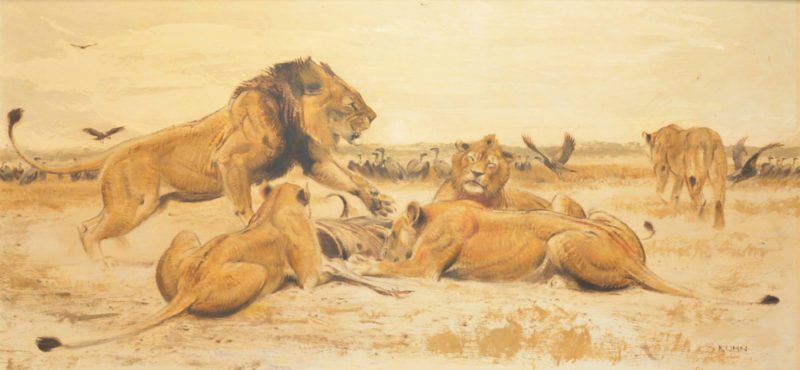
Lions on Kill, an oil on board by Bob Kuhn
Accordingly, as there was no tree of any kind close at hand, I had a staging erected some ten feet away from the body. This machan was about 12 feet high and composed of four poles stuck into the ground and inclined towards each other at the top, where a plank was lashed to serve as a seat. Further, as the nights were still pitch dark, I had the donkey’s carcass secured by strong wires to a neighboring stump, so that the lions might not be able to drag it away before I could get a shot at them.
At sundown, therefore, I took up my position on my airy perch, and much to the disgust of my gunbearer, Mahina, I decided to go alone. I would gladly have taken him with me, indeed, but he had a bad cough, and I was afraid lest he should make any involuntary noise or movement that might spoil all. Darkness fell almost immediately, and everything became extraordinarily still.
The silence of an African jungle on a dark night needs to be experienced to be realized; it is most impressive, especially when one is absolutely alone and isolated from one’s fellow creatures, as I was then. The solitude and stillness, and the purpose of my vigil, all had their effect on me, and from a condition of strained expectancy I gradually fell into a dreamy mood that harmonized well with my surroundings. Suddenly I was startled out of my reverie by the snapping of a twig; straining my ears for a further sound, I fancied I could hear the rustling of a large body forcing its way through the bush.
The man-eater, I thought to myself. Surely tonight my luck will change and I shall bag one of the brutes.
Profound silence again succeeded; I sat on my eyrie like a statue, every nerve tense with excitement. Very soon, however, all doubt as to the presence of the lion was dispelled. A deep, long-drawn sigh—a sure sign of hunger—came up from the bushes, and the rustling commenced again as he cautiously advanced. In a moment or two a sudden stop, followed by an angry growl, told me that my presence had been noticed, and I began to fear that disappointment awaited me once more.
But no; matters quickly took an unexpected turn. The hunter became the hunted, and instead of either making off or coming for the bait prepared for him, the lion began stealthily to stalk me! For about two hours he horrified me by slowly creeping round and round my crazy structure, gradually edging his way nearer and nearer. Every moment I expected him to rush it, and the staging had not been constructed with an eye to such a possibility. If one of the rather flimsy poles should break, or if the lion could spring the 12 feet that separated me from the ground…the thought was scarcely a pleasant one.
I began to feel distinctly “creepy” and heartily repented my folly in having placed myself in such a dangerous position. I kept perfectly still, however, hardly daring even to blink my eyes, but the long-continued strain was telling on my nerves.

My feelings may be better imagined than described when about midnight suddenly something came flop and struck me on the back of the head. For a moment I was so terrified that I nearly fell off the plank, as I thought that the lion had sprung on me from behind. Regaining my senses in a second or two, I realized that I had been hit by nothing more formidable than an owl, which had doubtless mistaken me for the branch of a tree—not a very alarming thing to happen in ordinary circumstances, I admit, but coming at the time it did, it almost paralyzed me. The involuntary start that I could not help giving was immediately answered by a sinister growl from below.
After this I again kept as still as I could, though absolutely trembling with excitement, and in a short while I heard the lion begin to creep stealthily towards me. I could barely make out his form as he crouched among the whitish undergrowth, but I saw enough for my purpose, and before he could come any nearer, I took careful aim and pulled the trigger. The sound of the shot was at once followed by a most terrific roar, and then I could hear him leaping about in all directions. I was no longer able to see him, however, as his first bound had taken him into the thick bush, but to make assurance doubly sure, I kept blazing away in the direction in which I heard him plunging about.
At length came a series of mighty groans, gradually subsiding into deep sighs, and finally ceasing altogether, and I felt convinced that one of the “devils” who had so long harried us would trouble us no more.
As soon as I ceased firing, a tumult of inquiring voices was borne across the dark jungle from the men in camp about a quarter of a mile away. I shouted back that I was safe and sound and that one of the lions was dead, whereupon such a mighty cheer went up from all the camps as must have astonished the denizens of the jungle for miles around.
Shortly I saw scores of lights twinkling through the bushes: Every man in camp turned out, and with tom-toms beating and horns blowing came running to the scene. I refused to allow any search to be made that night for the body of the lion, in case his companion might be close by; besides, it was possible that he might be still alive and capable of making a last spring. Accordingly we all returned in triumph to the camp, where great rejoicings were kept up for the remainder of the night, the Swahili and other African natives celebrating the occasion by an especially wild and savage dance.
For my part, I anxiously awaited the dawn. Even before it was thoroughly light I was on my way to the eventful spot, as I could not completely persuade myself that even yet the “devil” might not have eluded me in some uncanny and mysterious way. Happily my fears proved groundless, and I was relieved to find that my luck—after playing me so many exasperating tricks—had really turned at last. I had scarcely traced the blood for more than a few paces when, on rounding a bush, I was startled to see a huge lion right in front of me, seemingly alive and crouching for a spring. On looking closer, however, I satisfied myself that he was really and truly stone-dead, whereupon my followers crowded round, laughed and danced and shouted with joy like children, and bore me in triumph shoulder-high round the dead body.
These thanksgiving ceremonies being over, I examined the body and found that two bullets had taken effect—one close behind the left shoulder, evidently penetrating the heart, and the other in the off hind leg. The prize was indeed one to be proud of—his length from tip of nose to tip of tail was nine feet, eight inches; he stood three feet, nine inches high; and it took eight men to carry him back to camp. The only blemish was that the skin was much scored by the boma thorns through which he had so often forced his way in carrying off his victims.
The news of the death of one of the notorious man-eaters soon spread far and wide over the country: telegrams of congratulation came pouring in, and scores of people flocked from up and down the railway to see the skin for themselves.
Note: This passage was excerpted from J.H. Patterson’s The Man-Eaters of Tsavo, available in the Sporting Classics Store.
Read about the death of the second man-eater.
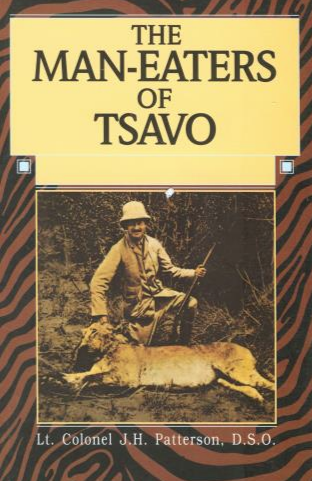 In 1898 John H. Patterson arrived in East Africa with a mission to build a railway bridge over the Tsavo River. Over the course of several weeks Patterson and his mostly Indian workforce were systematically hunted by two man-eating lions. In all, 100 workers were killed, and the entire bridge-building project was delayed.
In 1898 John H. Patterson arrived in East Africa with a mission to build a railway bridge over the Tsavo River. Over the course of several weeks Patterson and his mostly Indian workforce were systematically hunted by two man-eating lions. In all, 100 workers were killed, and the entire bridge-building project was delayed.
As well as being stalked by lions, Patterson had to guard his back against his own increasingly hostile and mutinous workers as he set out to track and kill the man-eaters. Patterson’s account of the lions’ reign of terror and his own attempts to kill them is the stuff of great adventure.
Consider this description of the aftermath of an attack by the lions: “…we at once set out to follow the brutes, Mr. Dalgairns feeling confident that he had wounded one of them, as there was a trail on the sand like that of the toes of a broken limb…. we saw in the gloom what we at first took to be a lion cub; closer inspection, however, showed it to be the remains of the unfortunate coolie, which the man-eaters had evidently abandoned at our approach. The legs, one arm and half the body had been eaten, and it was the stiff fingers of the other arm trailing along the sand which had left the marks we had taken to be the trail of a wounded lion….”
Originally published in 1907, this classic tale of death, courage and terror in the African bush is still a page-turner, even after all these years. Shop Now

